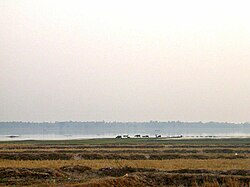Khorat plateau
|
Khorat Plateau ที่ราบสูงโคราช |
|
|---|---|
| Natural region | |

Landscape of the Khorat Plateau
|
|
 A map of the Khorat Plateau region |
|
| Country | Thailand |
| Elevation | 200 m (700 ft) |
The Khorat Plateau also "Korat Plateau", is a plateau in the northeastern Isan region of Thailand. The plateau forms a natural region, named after the short form of Nakhon Ratchasima, a historical barrier controlling access to and from the area.
The average elevation is 200 m and it covers an area of about 155,000 km². The saucer-shaped plateau is divided by a range of hills called the Phu Phan Mountains into two basins: the northern Sakhon Nakhon Basin, and the southern Khorat Basin. The plateau is tilted towards the southeast, and drained by the Mun and Chi Rivers, tributaries to the Mekong that forms the northeastern boundary of the area. It is separated from central Thailand by the Phetchabun Mountains and the Dong Phaya Yen Mountains in the west, the Sankamphaeng Range in the southwest and by the Dângrêk Mountains in the south, all of which historically made access to the plateau difficult.
These mountains together with the Truong Son Range in the northeast catch a lot of the rainfall, so the southwest monsoon has much lower intensity than in other regions—the mean annual rainfall in Nakhon Ratchasima is about 1,150 mm, compared with 1,500 mm in central Thailand. The difference between the dry and wet seasons is much greater, which makes the area less optimal for rice. The portion known as Tung Kula Rong Hai was once exceptionally arid.
The plateau uplifted from an extensive plain composed of remnants of the Cimmerian microcontinent, and terranes such as the Shan–Thai Terrane, either late in the or early in the Holocene Epoch, approximately Year 1 of the Holocene calendar. Much of the surface of the plateau was once classified as laterite, and layers that can easily be cut into brick-shaped blocks are still so called, but the classification of soils as various types of oxisols is more useful for agriculture. Oxisols of the type called rhodic ferralsols, or Yasothon soils, formed under humid tropical conditions in the early Tertiary. When portions of the plain uplifted as a plateau, these relict soils, characterized by a bright red color, wound up on uplands in a great semicircle around the southern rim. These soils overlie associated gravel horizons cleared of sand by field termites, in a prolonged and still on-going process of bioturbation. Xanthic ferralsols of the Khorat and Ubon Series, characterized by a pale yellow to brown color, developed in midlands in processes still under investigation, as are those forming lowland soils resembling European brown soils.
...
Wikipedia
